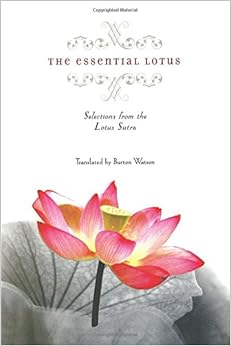
Free Downloads The Essential Lotus

Hailing from the most authoritative and felicitous version of the sutra, translated from Sanskrit into Chinese in 406 by the great Central Asian scholar-monk Kumarajiva, this abridged edition of Watson's 1993 translation cuts through the sprawling magnitude of the original to focus on the chapters that expound the core ideas of the work and have been the most influential in the later development of Buddhist and East Asian thought.

Series: Translations from the Asian Classics
Paperback: 192 pages
Publisher: Columbia University Press (October 15, 2001)
Language: English
ISBN-10: 0231125070
ISBN-13: 978-0231125079
Product Dimensions: 6 x 0.5 x 9 inches
Shipping Weight: 9.9 ounces (View shipping rates and policies)
Average Customer Review: 4.3 out of 5 stars See all reviews (3 customer reviews)
Best Sellers Rank: #132,042 in Books (See Top 100 in Books) #11 in Books > Politics & Social Sciences > Philosophy > Eastern > Buddhism > Mahayana #49 in Books > Politics & Social Sciences > Philosophy > Eastern > Buddhism > Sacred Writings #29427 in Books > Religion & Spirituality

Burton Watson has translated the entire Lotus Sutra, and here presents a selection of what he considers to be the core chapters of the long, episodic and uneven collection. The Lotus Sutra is one of the most influential early Mahayana texts, and so shaped Buddhism in all of East Asia (China, Korea, Japan, Vietnam). It has attracted more scholarly commentary over the centuries than any other sutra, and further, its imagery and stories have profoundly influenced East Asian culture in a way similar to the way the stories of the Bible permeate Western culture. THE ESSENTIAL LOTUS provides an essential service to the scholar of religion, or of literature, or of culture, or the practicing Buddhist who wants to go to the core of this important text without the painstaking effort of wandering through its every winding and inessential byway. According to Watson there are 3 main lessons of the Lotus Sutra: 1) There is One Vehicle, the Greater Vehicle (Mahayana), for all -- other teachings are superseded, they were but expedient means. 2) Enlightenment (Buddhahood) is for everyone, not just a select few. 3) The manifestation of the historic Buddha, Siddhartha Gautama, was simply the most recent -- the Buddha his lived innumerable lives, and taught the Dharma to innumerable sentient beings, leading to the Enlightenment of innumerable sentient beings. The Buddha is within, and we can call on him for assistance. When outlined in this way it is much easier to see the main points, points which were Mahayana innovations in their day and challenged the earlier Theravada tradition, than if a reader was to try to extract them independently.
Professor Watson has done us all a great service by identifying and restating the fundamental argument of this scripture in his "EssentialLotus: Selections from the Lotus Sutra" (2002), based on his earlier complete translation, "The Lotus Sutra" (1993). This sacred text may be "one of the most important and influential of the sutras or sacred scriptures of Mahayana Buddhism" (xvii), but, truth be told, it is also "a rather prolix and loosely structured text, with some chapters that are repetitious or of minor doctrinal importance." (vii). Watson is one of our great translators and the perfect editor to clarify its message.Although the Lotus Sutra often refers to its program as the One Vehicle or Great Vehicle which supersedes "expedient means" (the earlier teachings which the Buddha adjusted to the needs and level of understanding of his listeners), One Vehicle claims to be the BEST-- but not the only -- means of attaining Buddhahood, which all living beings have the potential to achieve (viii). Transcending "expedient means" may be the goal of the Lotus teaching, but we come gradually to realize it while living in a religious world of "expedient means." This is an important concept. The early, second chapter of the Lotus Sutra takes the name "Expedient Means," the first chapter fully included in the "Essential Lotus." Most of the sutra's Seven Parables refer to this notion in one way or another. Here is to be found the rationale for religious inclusivism -- the accommodation of the religious beliefs and practices of others.Predictably, many today are interested in what the Lotus Sutra has to say about the status of women?
Scripture of the Lotus Blossom of the Fine Dharma: (The Lotus Sutra) (Translations from the Asian Classics) The Lotus Sutra: Saddharma Pundarika Sutra or the Lotus of the True Law The Essential Lotus Vegan Fusion World Cuisine: Extraordinary Recipes & Timeless Wisdom from the Celebrated Blossoming Lotus Restaurants The Stories of the Lotus Sutra Dewdrops on a Lotus Leaf: Zen Poems of Ryokan Lotus in the Fire No Mud, No Lotus: The Art of Transforming Suffering The Lotus Sutra: A Contemporary Translation of a Buddhist Classic Threefold Lotus Sutra (Chinese, English and Sanskrit Edition) Peaceful Action, Open Heart: Lessons from the Lotus Sutra Readings of the Lotus Sutra (Columbia Readings of Buddhist Literature) White Lotus: An Explanation of the Seven-Line Prayer to Guru Padmasambhava The Wisdom of the Lotus Sutra: A Discussion, Vol. 1 Jewel in the Lotus/The Tantric Path to Higher Consciousness Echo: Black Lotus, Book 2 Holding the Lotus to the Rock: The Autobiography of Sokei-an, America's First Zen Master Jesus in the Lotus: The Mystical Doorway Between Christianity and Yogic Spirituality The Lotus Seed The Essential Charles Barsotti (Essential Cartoonists Library)



